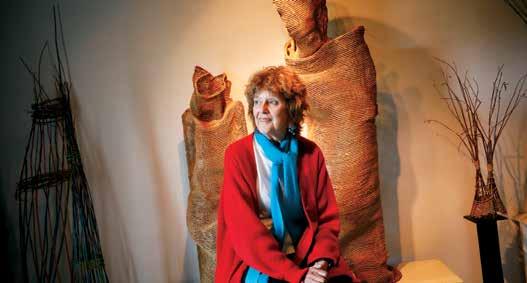
4 minute read
Off the Wall
Little Harbour artist Dawn MacNutt on creating, intuition and doing something a little wild and crazy
BY JANET WHITMAN
PHOTOS BY STEVE SMITH, VISIONFIRE STUDIOS
While music was de rigueur growing up in New Glasgow in the 1940s, Dawn MacNutt was drawn to art. At 12 or 13, she sold Christmas cards doorto-door to pay for lessons. “There wasn’t anything in school beyond grade one or two, but I was determined,” the now internationally celebrated artist and sculptor recalls from her home in Little Harbour. “Mom was alone and teaching, so I knew if I wanted art lessons, I’d better do something about it.” MacNutt never imagined making a living as an artist. At Mount Allison University in the 1950s, she majored in psychology with a minor in fine art. She got early encouragement from famed Maritime painter Alex Colville, who was teaching at the school, and wondered why she wasn’t enrolled in the fine arts program full time after seeing her work in the studio. “I didn’t have the confidence,” says MacNutt. “I was young when I went there.” Art was a part-time endeavour for the first half of her adult life. From the 1970s through the mid-1990s, her job was three-pronged. She was a mother raising three children, working full time as a social worker and evolving as a weaver and sculptor. Her first big commission was for the Bedford Institute of Oceanography in the late 1970s, an era when the federal government supported art in public buildings. She wove the 4x3-metre piece,
The beauty of

PHOTO CONTRIBUTED
dubbed Aquamarine, on a loom behind her furnace in her 2x2-metre studio in the basement of her Dartmouth home. Its seven panels, each one 4 metres long and 91 cm wide, were designed to undulate on suspended aluminium rods. Her tiny workspace meant no test run before it was hung in the new building. “I would complete one panel, measure carefully and roll it up,” she says. “By some miracle, it worked.” The money “wasn’t as big as it is today,” she says. “But it was major. It felt like acceptance.” The next leap in her career came in the late 1980s, when she was commissioned to do a piece for Alderney Gate, the civic centre complex developer Michael Zatzman was constructing in downtown Dartmouth. MacNutt imagined they’d want something along the lines of her recent exhibited work of woven copper wire and seagrass. The building’s designer, renowned Halifax architect Roy Willwerth, urged her to do something more. “Roy knew my dream was to recreate weaving for outdoors,” says MacNutt. “He said, ‘Why don’t you go for your dream. Do what you want.’ And so I did.” The pieces installed at the front of Alderney Gate, called Bronze Kindred Spirits, marked the beginning of the work she’s perhaps best known for today — life-size woven bronze sculptures that can withstand the elements. “It was an opportunity to present work that is woven and has that feel, but it will endure, unlike bare willow,” says MacNutt. “It was wonderful, a real leap of faith on their part. They’re still there, pretty much unchanged.” The pieces are expensive to make. They’re constructed of combustible materials, such as willow branches or old fishermen’s rope, then dipped repeatedly in molten
bronze. “It’s different than normal bronze casting because there are all kinds of entry points for the bronze to go in,” says MacNutt. In the mid-1990s, with her kids grown, MacNutt decided to pursue art full time. “True to form, of course, the first few years were lean,” she says. “I didn’t jump until I had a year or two of sustenance. It worked.” She moved back to Pictou County in 2006 after reconnecting with widower Merle Pratt at a Mount A class reunion. The recently married couple was halfway through cleaning out and renovating an old, abandoned home at the back of their property for a studio when they discovered MacNutt’s great, great, great grandfather had built it. “It was a crazy synchronicity,” she says. “I take pleasure in touching the wood and realizing some of the hand-hewn beams were done by my ancestor.” MacNutt isn’t a perfectionist. “The spirit of the piece or the flow of the piece is more important to me than technique,” she says. “I work a lot more intuitively.” Her inspiration is what she calls “the beauty of human frailty. We admire perfection. But what we’re drawn to are people’s frailties or vulnerabilities.” Her main work is semi-abstract and almost always reflects the human form. MacNutt, 84 in June, is busy archiving her work these days. “Because of my age, I’m interested in trying to record where things are,” she says. “Whether I sell my work or not wasn’t an incentive so much as if I could afford to make my work through the years. I just wanted to sell enough to support doing something that was perhaps a little wild and crazy.” beauty of human frailty










